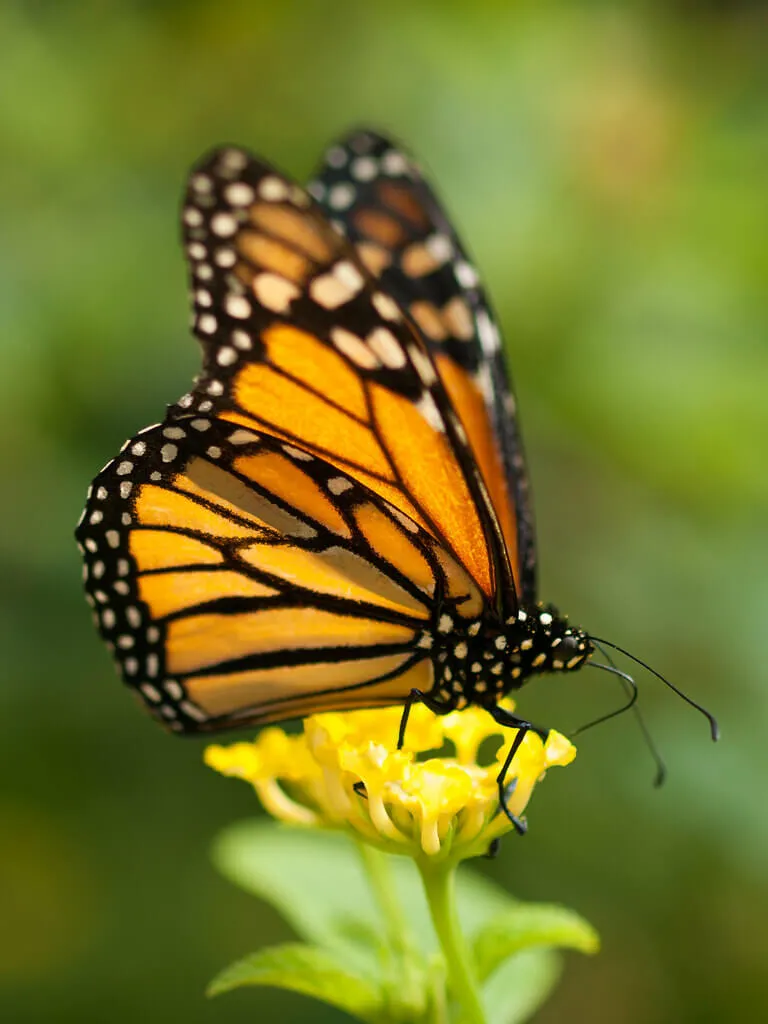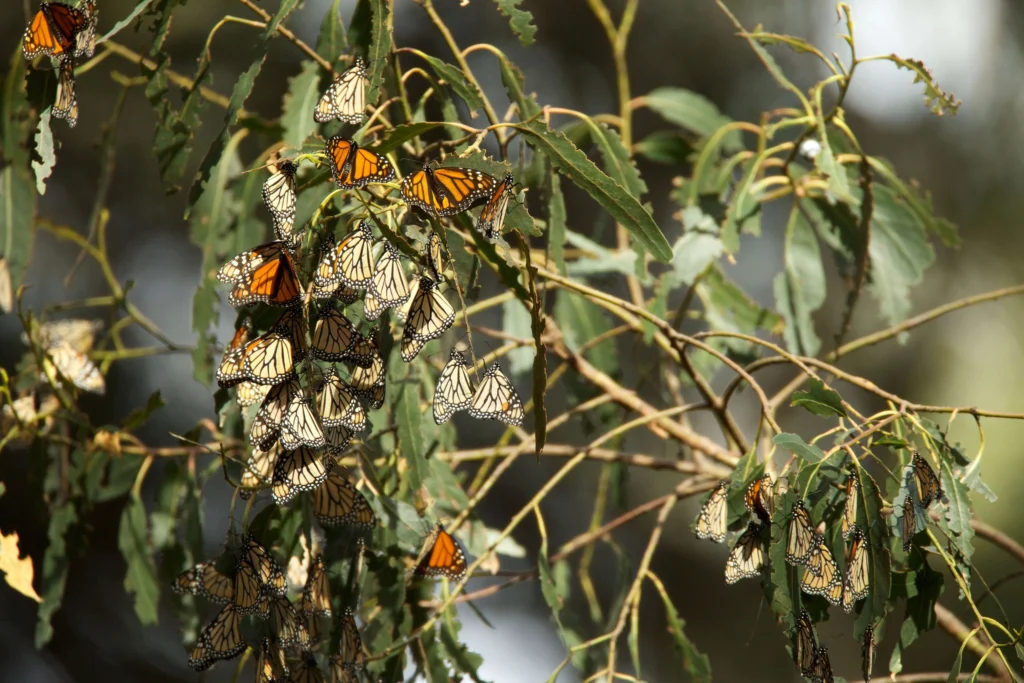Why Do Monarch Butterflies Migrate? Survival, Breeding & More
Monarch butterflies migrate to ensure survival, accessing essential resources like milkweed throughout the year. As temperatures drop, they move to warmer climates to escape freezing conditions, with Mexico offering a unique winter retreat. Their migration north, especially to regions like Canada, provides abundant summer habitats for breeding and laying eggs. This journey reduces predator exposure and optimizes reproductive success. Guided by environmental cues like temperature and daylight, monarchs’ migration is a testament to nature’s intricate balance and their enduring resilience.
Table of Contents
Introduction
Monarch butterflies are special creatures. When we think about butterflies, we often imagine these orange and black beauties. But did you know that these butterflies go on a long, brave journey every year? This journey, or migration, is unique to monarch butterflies.
In this article, we will explore why monarch butterflies migrate. We’ll look at the challenges they face, the places they visit, and the amazing reasons behind their travels. So, if you’re curious about these wonderful insects and their big adventure, keep reading!
The Necessity of Migration for Survival
Monarch butterflies are like travelers. They move from one place to another for a very good reason. Just as we might take a trip to escape cold winters or enjoy a summer vacation, monarchs have their reasons too.
Their journey isn’t just a short trip; it’s a grand adventure covering thousands of miles, which is wonderfully detailed in the monarch butterfly migration complete guide.
Imagine if you lived somewhere where it got very cold and there wasn’t enough food. You’d want to move to a warmer place with lots of food, right? Well, monarch butterflies do the same thing. But it’s not just about comfort; it’s about survival.
Facing the Challenges of Seasons
Every year, as the seasons change, some places become too cold for monarchs to live. The cold can hurt them. These delicate creatures need warmth to keep their bodies moving. Plus, when it’s cold, the plants they rely on can’t grow. This means they can’t find the food they love.
If you’ve ever wondered about their diet, the article on what monarch butterflies eat? is a great resource.
Migration: A Lifesaver
This big journey they take is called migration. It’s a way for them to survive and live a happy butterfly life. They search for places that have warmth, safety, and food. By migrating, they can find all they need to thrive.
And if you’re curious about the different stages of their life, the monarch butterfly lifespan offers a deep dive into their incredible journey from caterpillar to butterfly.
The Pursuit of Milkweed
Every creature has a favorite food, and for the monarch butterfly, that special food is milkweed. Think of it as their most loved meal. Just as we might crave a certain dish, monarch butterflies search far and wide for milkweed. But it’s not just about taste; milkweed is essential for their survival.
The Role of Milkweed in the Monarch’s Life
Milkweed isn’t just a source of food; it’s also where monarch butterflies lay their eggs. When the tiny caterpillars hatch, they start munching on the milkweed leaves right away. This plant provides them with all the nutrients they need to grow into beautiful butterflies.
It’s like their own little nursery. If you’re keen on raising these magnificent creatures, you might find the Raising Monarch Butterflies Guide article enlightening.
Seasonal Scarcity and Migration
However, as seasons change, milkweed becomes harder to find in some places. In regions where winter is harsh, milkweed dies off, leaving monarchs with no place to lay their eggs or eat.
That’s one of the big reasons monarchs migrate. By moving to warmer areas, they can find more milkweed and ensure their young ones have a fighting chance at survival.
For those curious about the types of plants monarchs are drawn to, the monarch butterfly plants article offers a comprehensive list.
The Seasonal Cycle: Migration in the Fall and North in the Spring
Every season has its charm, but for monarch butterflies, the changing seasons are signals. Just like how we change our clothes or activities with the seasons, monarchs change their location.
Journeying South: The Fall Migration
As fall approaches, days become shorter, and temperatures begin to drop. This is the time when monarchs make a crucial decision: it’s time to move. But why do monarch butterflies migrate in the fall? It’s simple: to escape the impending cold.
Winter in many regions means freezing temperatures, snow, and the absence of milkweed. To ensure they survive and find food, monarchs embark on a journey south, sometimes traveling thousands of miles to warmer lands.
The Return Trip: Migrating North in Spring
As winter ends and spring begins to bloom, a new migration cycle starts. But why do monarch butterflies migrate north after spending the colder months in the south? The answer lies in the rebirth of their breeding grounds.
As temperatures rise, milkweed starts to sprout in northern regions. This means food and a place to lay eggs are available again. The monarchs then begin their trip north, aiming to reach places where they can continue their lifecycles.
The entire migration process is truly a testament to the adaptability and resilience of these beautiful creatures.
Escape from Cold Temperatures
Monarch butterflies, with their vibrant wings and graceful flight, might seem robust. But in reality, they’re quite delicate, especially when it comes to cold temperatures. These butterflies have a thin body, which makes it hard for them to keep warm when the weather gets chilly.
Why Cold is a Challenge
Cold temperatures can slow down a monarch’s body functions. When it’s too cold, they can’t fly, search for food, or escape from predators. Even worse, extremely cold conditions can be fatal. Imagine trying to move with stiff, frozen wings – it’s nearly impossible for the monarchs.
The Warmth of Southern Climes
To keep their bodies active and safe, monarchs need warmth. This is a big reason why they migrate to warmer areas during the fall. In these places, not only can they find food and lay eggs, but they can also ensure their bodies function properly.
The Mystique of Mexico: A Winter Retreat
Mexico holds a special place in the heart of the monarch butterfly. To many of us, Mexico might be known for its rich culture, delicious food, and vibrant festivals. But for monarchs, it’s a haven, a sanctuary, and a place to rejuvenate.
So Why Do Monarch Butterflies Migrate To Mexico?
The forests of Mexico, especially in the Michoacán region, provide the perfect climate for these butterflies during the winter months. The temperatures here are cool but not freezing, allowing the monarchs to be dormant without risking their lives in extreme cold.
These forests also offer the protection of dense oyamel fir trees. These trees act as a blanket, shielding the butterflies from rain and cold winds. Together, they create an environment where millions of monarchs can cluster together, conserve their energy, and survive the winter.
The Remarkable Congregation
One of the most breathtaking sights in nature is watching these forests during the monarch’s stay. Trees appear orange and black as they get covered by thousands of resting butterflies.
The sheer number of monarchs in one place is both a testament to the success of their migration and a reminder of the critical role Mexico plays in their lifecycle.
The Northern Appeal: Journeying to Canada
When we think of Canada, images of maple leaves, hockey, and vast landscapes might come to mind. But for monarch butterflies, Canada represents a bountiful summer playground filled with resources and breeding opportunities.
The Allure of the North
But why do monarch butterflies migrate to Canada? As the harshness of winter subsides and spring emerges, Canada becomes a land of plenty for monarchs. The vast meadows and fields begin to bloom, and most importantly, milkweed proliferates in abundance.
This provides the butterflies with ample nourishment and ideal spots to lay their eggs.
Breeding and Expansion
Canada’s summer offers a perfect climate for monarchs to breed. With longer days and abundant food, the butterflies engage in a frenetic period of mating and egg-laying. This ensures the next generation of monarchs is strong and ready to face the challenges ahead.
The country’s expansive landscapes also mean less competition for resources, allowing the monarch population to thrive.
It’s truly wondrous how a creature as delicate as the monarch butterfly can traverse such long distances, from the warmer climes of Mexico to the inviting summers of Canada. Their journey is not just about survival but also about continuing the legacy of their species, generation after generation.
Reduced Risk of Predation

In the vast tapestry of nature, every creature plays its part. For monarch butterflies, their vibrant colors and delicate wings make them a visual treat. But these same attributes can also draw the attention of hungry predators.
Predators on the Prowl
Birds, small animals, and even other insects are always on the lookout for a tasty treat. Monarchs, with their slow, graceful flight, can be easy targets.
While they have developed some defensive mechanisms — like the toxins they acquire from milkweed making them unpalatable to many predators — migration plays a crucial role in their survival strategy.
How Migration Helps
By constantly moving from one place to another, monarchs reduce their exposure to certain predators. A region where they might have become easy prey sees its monarch population decrease as they migrate, making it harder for predators to rely on them as a consistent food source.
It’s like a game of musical chairs; just as a predator gets accustomed to their presence, the monarchs are off to a new location.
Safety in Numbers
Another fascinating aspect of their migration, especially when they cluster in places like the forests of Mexico, is the sheer number of butterflies in one location.
This congregation can be overwhelming for potential predators. It’s a strategy of safety in numbers; individual monarchs are safer when part of a larger group.
Reproductive Advantages

The primary goal of any species is to ensure its continuity, and monarch butterflies are no exception. While their mesmerizing flight and stunning colors are delights to our eyes, these features play crucial roles in their reproductive dances.
A Cycle of Renewal
Migration isn’t merely an act of survival; it’s intrinsically tied to the monarch’s reproductive cycle. When monarchs travel, they’re not just searching for food or warmth—they’re also seeking ideal conditions to mate and lay eggs.
Why Migrate for Breeding?
You might wonder, why not just stay in one place and reproduce there? The answer lies in the freshness of resources and the reduction of competition. As monarchs spread out over vast areas, from Mexico to Canada, they found a bounty of milkweed and fewer competitors for these resources.
This ensures that each generation has the best possible start in life.
Maximizing Chances
By constantly moving, monarchs can also maximize their chances of finding a mate. In locations filled with monarchs, such as their wintering spots in Mexico, the probability of encountering a mate is high.
But as they travel north, spreading out, it’s the continuous movement that ensures they encounter other monarchs with whom they can mate.
Laying the Foundation for the Next Generation
After mating, the next vital step is finding the perfect spot to lay eggs. With the abundance of milkweed in places like Canada during the summer, monarchs can find plenty of safe spots to lay their eggs.
These eggs will hatch, giving birth to the next generation that will continue the migration cycle, ensuring the monarch’s legacy lives on.
The Role of Environmental Cues
The world is vast, filled with countless landscapes and changing climates. It’s awe-inspiring to think that the tiny monarch butterfly, with just its innate senses, can navigate this expanse with such precision. How do they do it?
The Power of Temperature and Daylight
Monarchs, like many creatures, are finely tuned to the environment around them. One of the most critical cues they rely on is temperature. As seasons change and temperatures fluctuate, monarchs sense these shifts. Cold snaps signal the need to move to warmer locales while warming trends indicate it might be time to head north.
Daylight, or the length of day, is another significant cue. As days get shorter in the fall, monarchs are prompted to begin their migration south. Conversely, as the days lengthen in the spring, the urge to travel north and breed becomes strong.
Other Sensory Tools
While temperature and daylight play pivotal roles, monarchs also possess a sort of internal compass. Some research suggests they can detect the Earth’s magnetic field, helping them maintain a directional course. Their incredible eyesight aids in recognizing landmarks and maintaining their path.
It’s a delicate dance between the monarch and Mother Nature. These butterflies, with their vibrant wings, don’t just flutter aimlessly. Every move and every flight pattern is a response to the world around them.
By understanding and reacting to environmental cues, monarchs ensure their survival and the continuation of their species.
Conclusion
Throughout our exploration into Why do monarch butterflies migrate, we’ve seen that this isn’t just a simple movement across territories. it’s a testament to the resilience and wonders of nature. From the dense forests of Mexico to the expansive meadows of Canada, monarchs traverse thousands of miles, facing innumerable challenges, and yet, year after year, they persevere.
The Delicate Balance of Nature
Their journey sheds light on the intricate balance within our ecosystem. Every flower, every gust of wind, and every ray of sunlight plays a role in this grand tapestry. The monarch’s migration serves as a reminder of how interconnected our world is and how each creature, no matter how small, plays a pivotal role.
Preserving the Legacy
With the increasing challenges posed by climate change and habitat loss, it’s crucial for us to recognize the importance of conserving these natural wonders. By understanding and valuing their journey, we can take steps to ensure that future generations also get to witness the mesmerizing dance of monarch butterflies.
A Final Thought
In the end, the story of the monarch is not just about a butterfly. It’s about endurance, adaptation, and the wonders of nature. It’s a story that inspires and reminds us of the beauty that surrounds us, waiting to be discovered and cherished.

